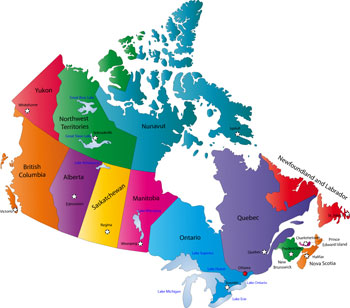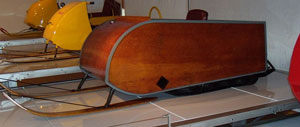FACTS ABOUT CANADA
LOCATION Canada stretches from the Atlantic Ocean to the Pacific Ocean. The Arctic Ocean is north and the United States is south.
Canada stretches from the Atlantic Ocean to the Pacific Ocean. The Arctic Ocean is north and the United States is south.
Canada is north of the 49th parallel of latitude. The 49th parallel was chosen as a border from the Great Lakes to the west coast.
Canada does not own the North Pole. In fact, the North Pole is not owned by any country.
NORTH - SOUTH - EAST and WEST
Northern-most town - Grise Fiord on Ellesmere Island (NT).
Southern-most point - Middle Island, Lake Erie (ON).
Southern-most town - Pelee Island (ON).
Western-most point - The Yukon/Alaska border on the Pacific Coast.
Western-most town - Beaver Creek (YT).
Eastern-most point in North America - Cape Spear (NF).
Eastern-most town - Blackhead (St. John's district)(NF).
Exact Centre of Canada - Arviat, Nunavut is in the exact centre of Canada (measured North, South, East and West)
FACTS
Canada is the second largest country in the world, with 9,971,000 square kilometres of land. (Russian Federation is the largest)
Canada has the ninth biggest economy of the world.
According to the United Nations Human Development Index, Canada has the highest quality of life in the world.
Canada is the home of many great inventions, including: basketball, the electric light bulb, the electric range, the electron microscope, standard time, the television, the telephone, and the zipper.
Canada has ten provinces and three territories (capital cities are in brackets). Provinces : Alberta (Edmonton), British Columbia (Victoria), Manitoba (Winnipeg), New Brunswick (Fredericton), Newfoundland and Labrador(St. John's), Nova Scotia (Halifax), Ontario (Toronto), Prince Edward Island (Charlottetown), Quebec (Quebec City), Saskatchewan (Regina)
Territories : Yukon (Whitehorse), Nunavut (Iqaluit), Northwest Territories (Yellowknife),
Population - 34.0 million (2010)
Capital city of Canada - Ottawa (Ontario)
Emblem - maple leaf
Flag - red and white with a red maple leaf
Canada's birthday is on the first of July.
National animal - the beaver
Motto - "From sea to sea"
National anthem - "O Canada" “O Canada,” was originally named “Chant national,” and was written in 1880. The song was approved by the Parliament of Canada in 1967 as the unofficial national anthem and adopted officially on July 1, 1980.
RCMP (Royal Canadian Mounted Police) the national police force
There are six time zones: : Pacific, Mountain, Central, Eastern, Atlantic and Newfoundland time.
Annual Births: 377,703 (to June 30 2009)
Life Expectancy through the years for Canadians
| Year of Birth | Life Expectancy Males (years) | Life Expectancy Females (years) |
| 1920 to 1922 | 59 | 61 |
| 1930 to 1932 | 60 | 62 |
| 1940 to 1942 | 63 | 66 |
| 1950 to 1952 | 66 | 71 |
| 1960 to 1962 | 68 | 74 |
| 1970 to 1972 | 69 | 76 |
| 1980 to 1982 | 72 | 79 |
| 1990 to 1992 | 75 | 81 |
| 2000 to 2002 | 77 | 82 |
| 2005 | 78 | 83 |
THE PEOPLE
Most of the people live in the southern part of Canada.
Vancouver Canada is tied with Zurich Switzerland for the highest quality of life of any city in the world.
About 77 percent of Canadians live in cities and towns.
With only three people per square kilometer, Canada has the fourth lowest population density in the world.
The largest cities are Toronto, Montreal and Vancouver.(2006) Toronto - 5.5 million; Montreal - 3.6 million; Vancouver - 2.1 million
Canada's two official languages are English and French.
More than 9 million Canadians speak French.
LAND AND WATER
Canada has the world's longest coastline.
There are oceans on three sides - Pacific ( west), Atlantic ( east), Arctic (north).
Nearly one-fourth of all the fresh water in the world is in Canada.
There are over two million lakes in Canada, covering about 7.6 percent of the Canadian landmass. The main lakes, in order of the surface area located in Canada (many large lakes share the Canada-U.S. border), are Huron, Great Bear, Superior, Great Slave, Winnipeg, Erie and Ontario.
The Mackenzie River ( in the N.W.T. ) is the longest river in Canada.
Largest Rivers
Mackenzie- 4241 km
Yukon - 3185 km
St. Lawrence - 3058 km
Nelson - 2575 km
Columbia - 2000 km
Saskatchewan - 1939 km
Peace - 1923 km
Churchill - 1609 km
South Skatchewan - 1392 km
Fraser - 1370 km
North Saskatchewan - 1287 kkm
Ottawa - 1271 km
Athabasca - 1231 km
Liard - 1115 km
Assiniboine - 1070 km
Ships sail inland on the St. Lawrence River (from the Atlantic Ocean to the Great Lakes).
Forests cover almost half of Canada.
Canada has one-tenth of the world's forests.
Mount Logan in the Yukon Territory is Canada's tallest peak at 5,959 metres.
The border between Canada and the United States is officially known as the International Boundary. At 5,525 miles, including 1,538 miles between Canada and Alaska, it is the world's longest border between two nations.
HISTORY
The first people were the Aboriginal people.
Explorers and settlers from Western Europe arrived in the 1500s.
Canada was named by the French explorer Jacques Cartier (1535).
The name "Canada" comes from the Huron and Iroquois word "Kanata" meaning "village".
Canada became a country on July 1st, 1867.
The first provinces were Nova Scotia, New Brunswick, Ontario and Quebec.
The first prime minister was Sir John A. Macdonald.
RESOURCES
Hydroelectric power is sold to the United States.
Canada is one of the largest mining nations in the world.
Over 60 minerals and metals are produced in Canada.
Canada is the third largest diamond producing nation in the world.
Canada is the world's leader in the production of potash and uranium.
There are 42 national parks in Canada.
The largest park in Canada is Wood Buffalo National Park, in Alberta and the Northwest Territories. It is home of the world's largest bison herd and the only nesting site of the endangered whooping crane.
The oldest National Park is Banff in Alberta. It was created in 1885 as Rocky Mountain Park.
TRANSPORTATION
The main highway system (completed in 1962) is called the Trans-Canada Highway. It goes from St. John's NFLD to Victoria, B.C.
The Trans-Canada Highway length (using the Perth-Peterborough-Parry Sound route) is 7604 kilometres. It is the longest national highway in the world.
The Dempster Highway in the Yukon territory is the northernmost highway.
The major ports are Vancouver, Churchill, Montreal, Quebec City, Halifax and St. John's.
The St. Lawrence Seaway allows ocean-going ships to sail inland.
The Seaway has twenty-six locks and five canals.
The two main freight railway systems are the Canadian National and the Canadian Pacific Railway.
-Workers began to build the national railroad in 1872.
-The Canadian Pacific Railway was finished in 1885.
-Upon completion many settlers were able to travel west.
GOVERNMENT
Democratic system of government
Parliament consists of House of Commons (elected) and Senate (appointed)
Head of State: British Monarch
Head of Government: Prime Minister
Capital: Ottawa
SPORTS
The native people of Canada invented the game of lacrosse.
Lacrosse is the national summer sport of Canada.
Ice hockey is the winter national sport of Canada. The modern game of ice hockey was developed in Canada, based on games that have been played since the tenth century. The rules were first published in the Montreal Gazette in 1877.
The baseball glove was invented in Canada in 1883.
Five pin bowling was invented by T.E. Ryan of Toronto in 1909.
Basketball was invented by a Canadian James Naismith in 1891.
ODD FACTS
The world's smallest jail is believed to be in Rodney, Ontario, Canada. It is only 24.3 square meters (about 270 square feet).
North America's lowest recorded temperature was -81.4 degrees Fahrenheit (-63 C) at Snag, Yukon Territory, on February 3, 1947.
Canada is known as the home of large animals like the moose and grizzly bear, but it is also home to about 55,000 species of insects and about 11,000 species of mites and spiders.
Manitou Lake on Manitoulin Island in Lake Huron is the world's largest lake within a lake (41.1 square miles).
Canada is also the largest producer of a refreshingly sweet dessert wine called Icewine.
Canada has more lakes than the rest of the world combined.
Canada is over 40 times bigger than the UK and 18 times bigger than France.
Manitoulin Island in Lake Huron is the world's largest island in a freshwater lake with an area of 2765 sq. km. The oldest program in Canadian broadcasting history is Hockey Night In Canada. It first was on the radio in 1931, and in the Fall of 1952 the first TV hockey game was broadcast nationally on CBC. It is still being produced weekly in both English and French by the CBC.
The oldest program in Canadian broadcasting history is Hockey Night In Canada. It first was on the radio in 1931, and in the Fall of 1952 the first TV hockey game was broadcast nationally on CBC. It is still being produced weekly in both English and French by the CBC.
FACTS ABOUT CANADIAN INVENTIONS
Baseball glove, 1883
Basketball - James Naismith (1892)
Battery-less radio - Edward Samuel Rogers Sr. (1925)
Dental mirror
Ear piercer
Electrical car (North America's first)
Electric wheelchair - George J. Klein
Electron microscope - Prof. E. F. Burton and Cecil Hall, James Hillier and Albert Prebus (late 1930s)
Frozen fish - Dr. Archibald G. Huntsman (1926)
Heart valve operation (first)
Helicopter trap (for landing on ships)
Helium as a substitute for hydrogen in airships
IMAX - Grahame Ferguson, Roman Kroitor, Robert Kerr (1968)
Insulin (as diabetes treatment) - Dr. Frederick Banting, Dr. Charles Best and Dr. Collip (1921)
Kerosene - Abraham Gesner (1840)
Lightbulb (first patented) - Henry Woodward (1874)
Measure for footwear
Nursing Mother Breast Pads - Marsha Skrypuch (1986)
Pacemaker - Wilfred Bigelow
Paint roller - Norman Breakey (1940)
Panoramic camera - John Connon (1887)
Portable high chair
Radio compass
Rollerskate
Snowblower - Arthur Sicard (1927) Snowmobile - Joseph-Armand Bombardier (1937)
Snowmobile - Joseph-Armand Bombardier (1937)
Standard time - Sir Sanford Fleming (1879)
Superman - Joe Shuster and Jerome Siegel (1938)
Telephone - Alexander Graham Bell (1874)
Walkie-Talkie - Donald L. Hings (1942)
Washing machine
Zipper - Gideon Sundback (1913)
Music Synthesizer - Hugh LeCaine
AM radio - Guglielmo Marconi
Telephone - Alexander Graham Bell
Television - Reginald A. Fessenden